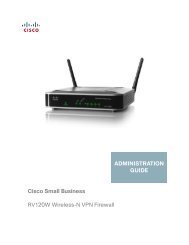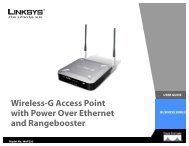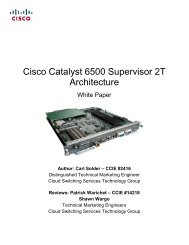Cisco EnergyWise IOS Configuration Guide - Ipland
Cisco EnergyWise IOS Configuration Guide - Ipland
Cisco EnergyWise IOS Configuration Guide - Ipland
You also want an ePaper? Increase the reach of your titles
YUMPU automatically turns print PDFs into web optimized ePapers that Google loves.
energywise domain<br />
Chapter 3<br />
<strong>EnergyWise</strong> CLI Commands<br />
energywise domain<br />
Use the energywise domain global configuration command to enable <strong>EnergyWise</strong> on a network device<br />
or endpoint, assign it to a domain, set the domain security mode, and set the domain password. Use the<br />
no form of this command to disable <strong>EnergyWise</strong> and to remove the <strong>EnergyWise</strong> configuration.<br />
energywise domain domain-name security {ntp-shared-secret | shared-secret} [0 | 7]<br />
shared-secret [protocol udp port udp-port-number [interface interface-id | ip ip-address]]<br />
no energywise domain<br />
Syntax Description domain domain-name Assigns a network device or endpoint to a domain with the specified<br />
domain-name.<br />
security<br />
{ntp-shared-secret |<br />
shared-secret} [0 | 7]<br />
shared-secret<br />
protocol udp port<br />
udp-port-number<br />
interface interface-id<br />
ip ip-address<br />
• You can enter alphanumeric characters and symbols such as #, (, $, !, and<br />
&.<br />
• Do not enter an asterisk (*) or a space between the characters or<br />
symbols.<br />
Sets the domain security mode and the domain password to authenticate all<br />
communication in the domain.<br />
• ntp-shared-secret—Uses a strong password with Network Time<br />
Protocol (NTP). If the time between members varies ±30 seconds the<br />
domain member or endpoint drops events.<br />
• shared-secret—Sets a strong domain password without NTP.<br />
• (Optional) 0—Uses a plain-text password.<br />
• (Optional) 7—Uses a hidden password.<br />
If you do not enter 0 or 7, the default is 0.<br />
• For the shared-secret<br />
– You can enter alphanumeric characters and symbols such as #, (, $,<br />
!, and &.<br />
– Do not enter an asterisk (*) or a space between the characters or<br />
symbols.<br />
(Optional) Specifies UDP as the communication protocol and specifies the<br />
UDP port that communicates with the domain.<br />
The range is from 1 to 65000.<br />
(Optional) Specifies the port that communicates with the domain if the IP<br />
address is dynamically assigned. We recommend that you specify the<br />
interface-id. You should use this in a bridged network.<br />
(Optional) Specifies the IP address that communicates with the domain if the<br />
interface is a switched virtual interface (SVI) and VLAN trunking protocol<br />
(VTP) pruning is enabled. You should use this in a routed network.<br />
3-14<br />
<strong>Cisco</strong> <strong>EnergyWise</strong> <strong>Configuration</strong> <strong>Guide</strong><br />
OL-19806-04

















